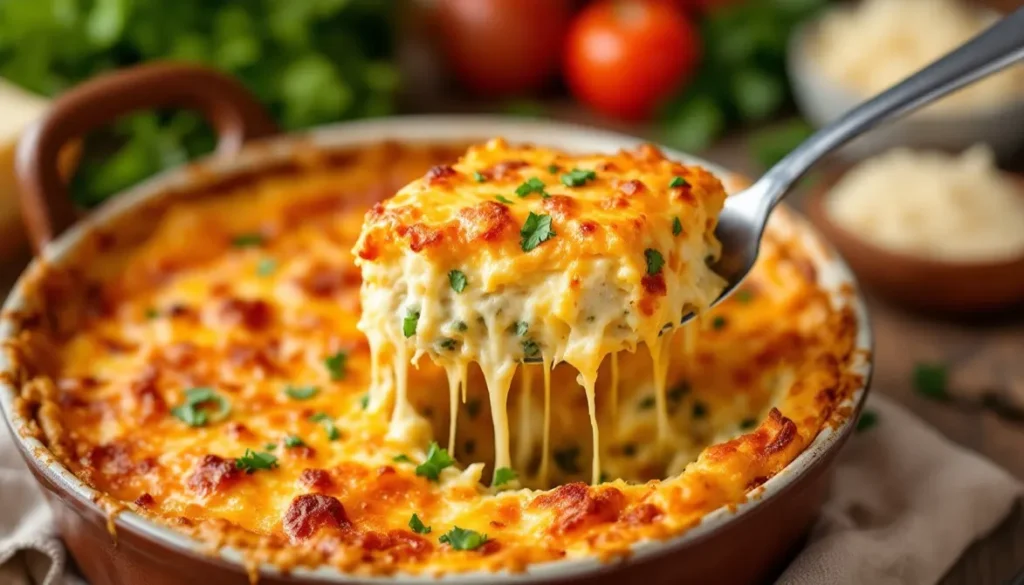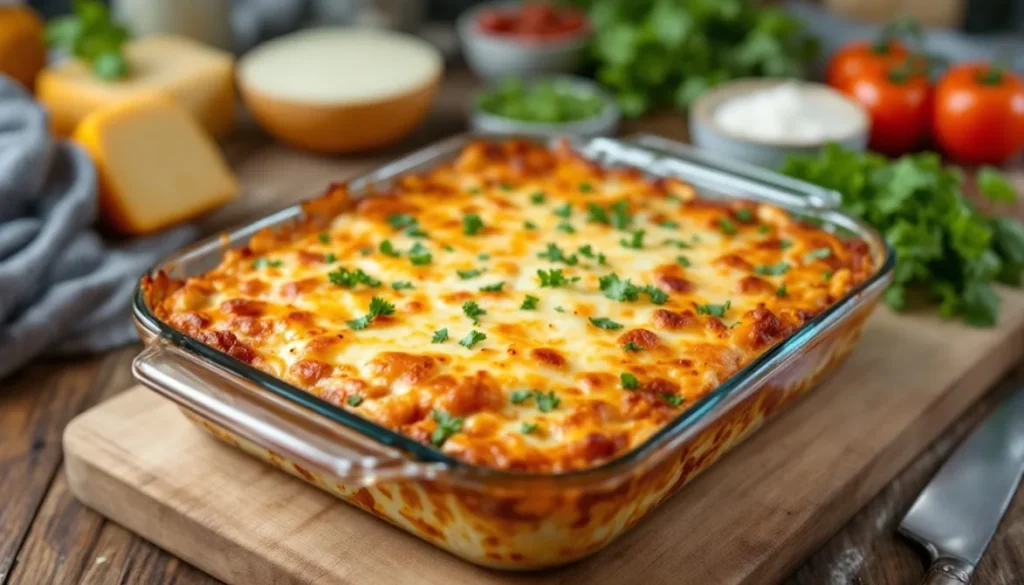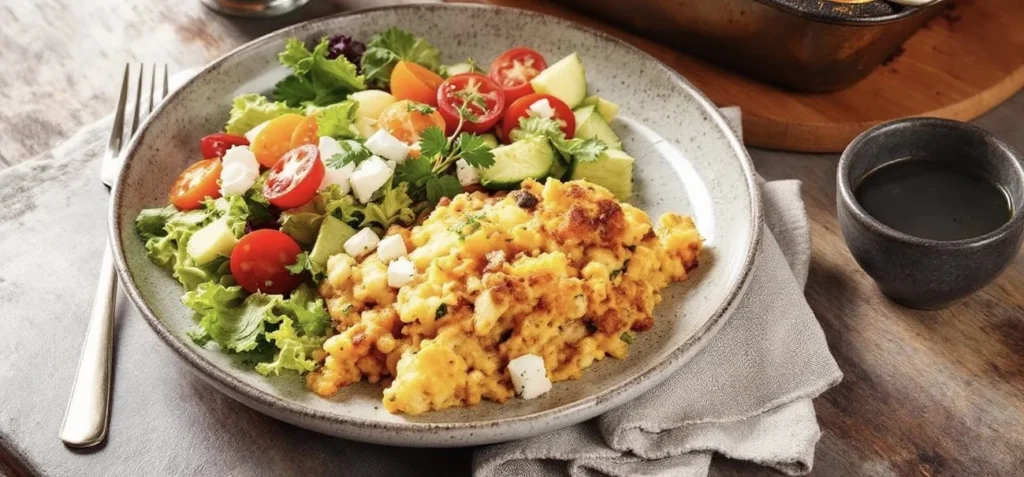What Makes a Good Casserole? The Ultimate Guide to Perfecting Your Recipe
A casserole is among the most cozy and flexible dishes you can prepare. If it’s a hearty dish for a family meal or a meal-prep option for busy days or a great choice for a crowd-pleaser during an event, casseroles are an endless array of options. What makes a great casserole? The secret is in the balance of flavors, textures, and ingredients, while employing the correct cooking techniques. This guide will teach you the art of making casseroles by breaking down the key components of a great dish.
The Foundation: Choosing the Right Base
A great casserole begins with a solid base. The base gives the structure, and usually contains ingredients such as pasta, potatoes, rice or grains. Each type of base adds distinct texture and taste in the meal:
- Pasta Soft and a comfortable texture. Macaroni, Penne, and egg noodles are all good choices.
- Rice It absorbs flavor beautifully, and provides a hearty flavor.
- Potatoes They have a smooth or crispy texture, based on if they’re cut, mashed or shred.
- Grains (like farro and quinoa): Add a chewy, nutty bite for an extra source of nutritional value.
The base you choose is crucial to ensure that the casserole is made with the proper consistency. When the base becomes soft or too firm it will impact the overall quality and taste of your dish.
Protein: The Heart of a Good Casserole
A delicious casserole is proteins that makes it delicious and healthy. The most nutritious options are:
- meat and poultry: Chicken, beef pork, turkey or are the most popular choices. Meat that has been cooked or browned is incorporated perfectly with the meal.
- Seafood Salmon, shrimp or tuna can be used in certain dishes.
- Plant-based Proteins: Beans, lentils tofu, chickpeas, and tofu are excellent vegetarian choices.
Protein must be seasoned thoroughly prior to adding it into the casserole to avoid blandness. Mixing flavors in this stage will enhance the overall taste and flavor.

Vegetables: Adding Color, Nutrition, and Flavor
Vegetables are an essential ingredient in a great casserole. They supply nutrients, color and texture. Certain vegetables work better than others when baked dishes.
- Strong vegetables: Carrots, bell peppers, and broccoli stand well when baked.
- Soft veggies: Mushrooms, zucchini and spinach expel water, which helps keep the casserole from drying out.
- Cans or frozen veggies: These work in the pinch, but they should be well drained to avoid a lot of liquid.
The addition of a mix of veggies provides a variety of flavors in every bite while increasing the nutritional quality of the food.
The Sauce: Bringing Everything Together
It is this sauce that connects all the ingredients together to create an incredibly delicious well-integrated dish. Without a great sauce, the dish can become dry or deficient in flavor. Some popular sauce options include:
- Creme-based sauces The cheese sauces, the bechamel or the soup of mushrooms add creamy flavor.
- Sauces made from tomatoes: Marinara or salsa are great in Italian as well Mexican-inspired dishes.
- Broth-based condiments The beef, poultry or vegetable broths keep the dish light, but tasty.
A great sauce must have the right consistency, neither too thick or thin or too runny. Also, it must be well-seasoned as it adds flavor to the dish.
Toppings: Creating the Perfect Finishing Touch
A delicious casserole requires an excellent topping to add taste and texture. Crispy, golden crust adds a touch of elegance and gives it an enjoyable crunch. The most popular toppings include:
- Cheese An extra layer of melty cheese can add the richness.
- Cookies: Make a crisp golden topping.
- Crackers or chips that are crushed: Add crunch and flavor.
- The seeds or nuts Give a distinctive and nutty texture.

To achieve the most optimal outcomes, toppings must be added at the end of 15 to 20 minutes after baking. This will ensure that they are crisp without burning.
Cooking Techniques: Achieving the Perfect Bake
The preparation of a casserole at proper temperature is crucial. The majority of casseroles cook at 350degF (175degC) to 350degF (175degC) to 375degF (190degC) for about 30 to 60 minutes dependent on the ingredients. Here are some suggestions to ensure even cooking
- Cook the ingredients prior to cooking if needed: If using raw meat or a large amount of vegetables, they need to be cooked in a small amount prior to adding to the casserole.
- Use foil to cover the top to ensure an even cooking process: This keeps that the surface from becoming scorched, while the interior heats up.
- Let it sit for a few hours before serving So letting the dish sit for 5-10 mins after baking will help the layers to set.
If you follow these tips to ensure your casserole cooks with the best texture.
Common Mistakes to Avoid
Even the most skilled cooks encounter problems when cooking casseroles. These are the most common blunders and tips to avoid these:
- Too many liquids: Adding too much sauce or using watery veggies can cause a soupy dish. Make sure to drain the ingredients thoroughly and make sure to use the proper quantity of liquid.
- overcooking Overcooking could cause drying out of the dish. Pay attention to the cooking time and test whether it is cooked.
- Subseasoning Casseroles require bold flavorings to be noticed. Sprinkle each layer by adding salt, herbs and other spices.
- Unsuitable toppings: Using toppings that can burn too fast (like delicate herb) or are sloppy could ruin the dish. Make sure to use strong and crisp toppings.
Making these blunders will help you create a balanced, tasty and delicious dish each time.
Customizing Your Casserole for Any Occasion
One of the greatest aspects of casseroles is that they are able to be modified to suit any taste or preference. Here are a few ways to alter your dish:
- For a healthier alternative: Use whole grains protein, lean meats, and lighter sauce.
- To create a rich and delicious meal: Add more cheese butter, cream, or other creamy sauces.
- To make a vegetarian choice: Swap meat for lentils, beans or tofu.
- for a low-carb chow: Use cauliflower or zucchini in place of rice or pasta.
Making your own casseroles allows you to play around and discover the best recipe to meet your requirements.
Why Casseroles Are the Ultimate Comfort Food
Casseroles can be more than an aperitif. They can are a way to bring people together. They’re great to share, simple to prepare ahead of time and can be great leftovers. If you’re cooking for your family, bringing food for a dinner party or preparing a meal for the week ahead, casseroles provide ease of preparation without sacrificing the flavor.
What makes a great casserole? It’s the perfect mix of food ingredients, well-balanced texture, delicious seasonings and the right cooking methods. With these suggestions to make the perfect dish that is not just tasty but also a hit on any dining table.

The Essential Components of a Great Casserole
To create a delicious casserole that’s tasty and satisfying, you’ll need the perfect combination of ingredients. Here’s what a great casserole should contain:
1. A Solid Base Ingredient
It is the base for your dish will give it the structure. Common base ingredients include:
- Pasta (e.g. macaroni, penne or egg noodles)
- It can be rice, or even grains (e.g. or quinoa wild rice, quinoa brown rice, or wild rice)
- Potatoes (e.g. chopped, mashed or diced)
- Bread (e.g. stuffing, breadcrumbs or breadcrumbs)
2. A Creamy or Savory Sauce
A thick sauce holds the ingredients and gives moisture. The most well-known options are:
- The cream-based condiments (e.g. bechamel, cheese sauce as well as cream of mushrooms soup)
- Tomato-based sauces (e.g., marinara or enchilada sauce)
- Broth-based sauces based on broth (e.g. beef, chicken and vegetable broth)
3. A Protein for Hearty Flavor
Incorporating protein in the dish makes it more nutritious. The best options include:
- Chicken (shredded or diced ground)
- Beef (ground or cut)
- Pork (sausage Ham, pork or bacon)
- Seafood (shrimp or salmon tuna)
- Proteins made from plants (tofu tempeh, tempeh, or lentils)
4. Vegetables for Nutrition and Texture
Vegetables can provide color, flavor and nutrients to your meal. Consider:
- Traditional choices: Onions bell peppers and mushrooms or carrots
- Leafy greens: Spinach cabbage, or kale
- Cans or frozen vegetables are available to make it easier
5. A Tasty Topping
A deliciously baked casserole requires crisp, golden topping. Some of the most popular choices are:
- Shredded cheese (cheddar, mozzarella, or Parmesan)
- Crackers, breadcrumbs, or crushed breadcrumbs
- Crispy, fried onions
- Crunch with seeds or nuts
How to Layer a Casserole for Perfect Texture
The method you use to layer the casserole will affect how it bakes and the flavors mix. Here’s a method for layering that is foolproof:
1. Begin with the Base
Place your rice, pasta potatoes, bread or pasta on the bottom of your dish. The water absorbs and helps keep the food together.
2. Add the Protein and Vegetables
Layer raw or cooked proteins evenly on the base. Sprinkle the vegetables over the top to ensure an uniform distribution.
3. Pour the Sauce Evenly
Make sure the sauce is covered with all ingredients, so the dish stays tasty and moist.
4. Top with cheese and crunchy Toppings
Sprinkle breadcrumbs or cheese on top for crisp, golden crust after baking.
Best Cooking Techniques for a Perfect Casserole
1. Baking Temperature and Time
The majority of dishes bake in 350 degrees Fahrenheit (175degC) for 30 to 60 minutes according to the ingredients.
2. Covering vs. Uncovering
- Make sure to cover the dish with foil during the first part of baking in order to prevent drying.
- Cover it for the final 10-15 minutes to create a crisp golden, gold top.
3. Pre-cooking Ingredients
- Cook rice and pasta lightly underdone, to avoid the rice from becoming too soft.
- The meat is first browned to improve the flavor and texture.
- Saute the vegetables prior to adding them to avoid excessive moisture.
How to Make a Casserole More Flavorful
1. Season Each Layer
Instead of merely seasoning the sauce, you can add salt and pepper along with other spices in each dish to create the fullness of flavor.
2. Use Fresh Herbs and Spices
Try basil, thyme oregano, or rosemary to get additional freshness.
3. Try different cheeses
Mix cheeses such as the sharp cheddar or smoked gouda and creamy ricotta for more flavor.
4. Balance Textures
A good casserole must be moist, chewy and chewy. Mixing various ingredients will give you an excellent taste.
Common Mistakes to Avoid When Making a Casserole
1. Using Too Much Liquid
In addition, overloading the sauce could cause the casserole to be watery. Limit the amount of liquid to cover the ingredients.
2. Overcooking the Dish
Baking too long could cause the casserole to dry out. Make sure that the center is cooked but not cooked to the point of overcooking.
3. Skipping the Resting Time
Allow the casserole to rest in the refrigerator for 5-10 minutes following baking to allow the flavors to set.
FAQs About Making the Best Casserole
PAA1: how can you stop a dish from becoming too watery?
To avoid a sloppy casserole remove any liquid that has accumulated from the vegetables, use thick sauces and prepare the ingredients to release water such as spinach and mushrooms.
PAA2: Can you cook an entire casserole in advance?
Yes! Put together your casserole, cover it and place it in the refrigerator until twenty-four hours prior to baking.
PAA3: What is the best method for freezing a recipe?
Cool the casserole thoroughly and then wrap it tightly in foil and plastic wrap and then store it in the freezer until three months. Thaw in the refrigerator before the reheating.
PAA4: What’s the secret of a crisp topping for your casserole?
To get a crisp top, place the casserole on the counter during the last 10 to 15 seconds of cooking and sprinkle on extra breadcrumbs or cheese.
PAA5 How do you heat an oven with no drying out?
Then cover with foil, and then bake the cake at 325°F (163degC) in 20 to 30 minutes with a splash of liquid or sauce if you need.
PAA6: Is it possible to cook a casserole with cheese?
Yes! Try creamy alternatives such as cashew cream, coconut milk or yogurt-based sauces to create an alternative that is dairy-free.
Conclusion: What Makes a Good Casserole?
A wonderful dish is much more than mixing ingredients together. It’s a balanced dish that provides warmth, comfort and a taste to each bite. From selecting the best base to mastering the art of layering Each step plays an important crucial role in preparing a tasty dinner. What makes a great casserole? It’s all about the correct ingredients, the right cooking techniques, and careful cooking.
The Importance of Balance in Flavor and Texture
A great casserole is about balanced ingredients. A lot of one ingredient can overwhelm the dish and too little could make it tasteless. The best casseroles are the right mix of flavors: savory mildly sweet, spicy, and tangy. This is achieved by incorporating ingredients such as sharp cheese, caramelized onions or even a little broth.
The texture is equally crucial. A well-constructed casserole should include layers that complement one another starting with a crisp topping to a smooth sauce under. If a dish isn’t moist enough it will become tough and bland. If it’s too moist, it becomes soft. The trick is to find the perfect combination of binding ingredients such as eggs, cheese and creamy sauces to help hold all the ingredients together while keeping it damp.
The Role of Quality Ingredients
The quality of the ingredients directly affects the final meal. fresh vegetables and well-seasoned protein and dairy products of high-quality provide better taste. Food items that are packaged or processed in a way can be useful however, they usually lack the depth of flavor. If you can, making home-cooked sauces and fresh herbs and even real cheese can elevate a basic casserole into something that is truly unique.
Mastering the Cooking Process
Baking at the correct temperature is a further important factor. Casseroles generally cook between 350degF to 350degF (175degC up to 190degC) to ensure an even cooking and avoid drying out. When the temperature is high, some edges could get burned before the interior is cooked completely. By covering the casserole with foil for a portion of the baking process helps to preserve the moisture, and removing it at the end of baking creates the most delicious crispy crust.
The timing is equally important. If the dish contains raw meat or a lot of vegetables such as potatoes, it will require more time to prepare. However, cooked ingredients need only enough time to cook and blend flavors. Verifying the cooking time with the thermometer or fork will ensure that the final texture is perfect.
Adapting Casseroles to Different Diets
One of the great things concerning casseroles is the flexibility. They are able to be easily modified to accommodate different needs for dietary requirements. For instance:
- Gluten-free Switch traditional pasta or breadcrumbs with gluten-free alternatives, such as quinoa and rice.
- Low-carb Choose zucchini or cauliflower instead of noodles or potatoes.
- Vegetarian or vegan: Replace meat with plants-based proteins such as lentils, beans or tofu.
- Dairy-free Make use of cashew-based condiments and dairy-free cheese in place of dairy-based products that are traditionally used.
Adjusting these recipes will allow everyone to have a delicious homemade dish without sacrificing flavor.
The Joy of Sharing Casseroles
Casseroles are much more than food; they bring people together. For family meals or a potluck dinner or even a festive meal casseroles are a symbol of warmth and unity. They can be prepared ahead of time, kept in the freezer to be later and served hot right out of the oven making them a delicious and practical choice for any occasion.
A great casserole doesn’t only require following the recipe. It’s about knowing the balance between flavors of the ingredients, textures, and flavors. It’s about applying the right methods to make dishes that are both cozy and tasty. Through experimenting with various techniques and ingredients it is possible to master the art of creating that perfect dish.
The next time you’re asked, “What makes a good casserole? “–remember, it’s the effort, imagination, and the quality of the ingredients that make the difference.

